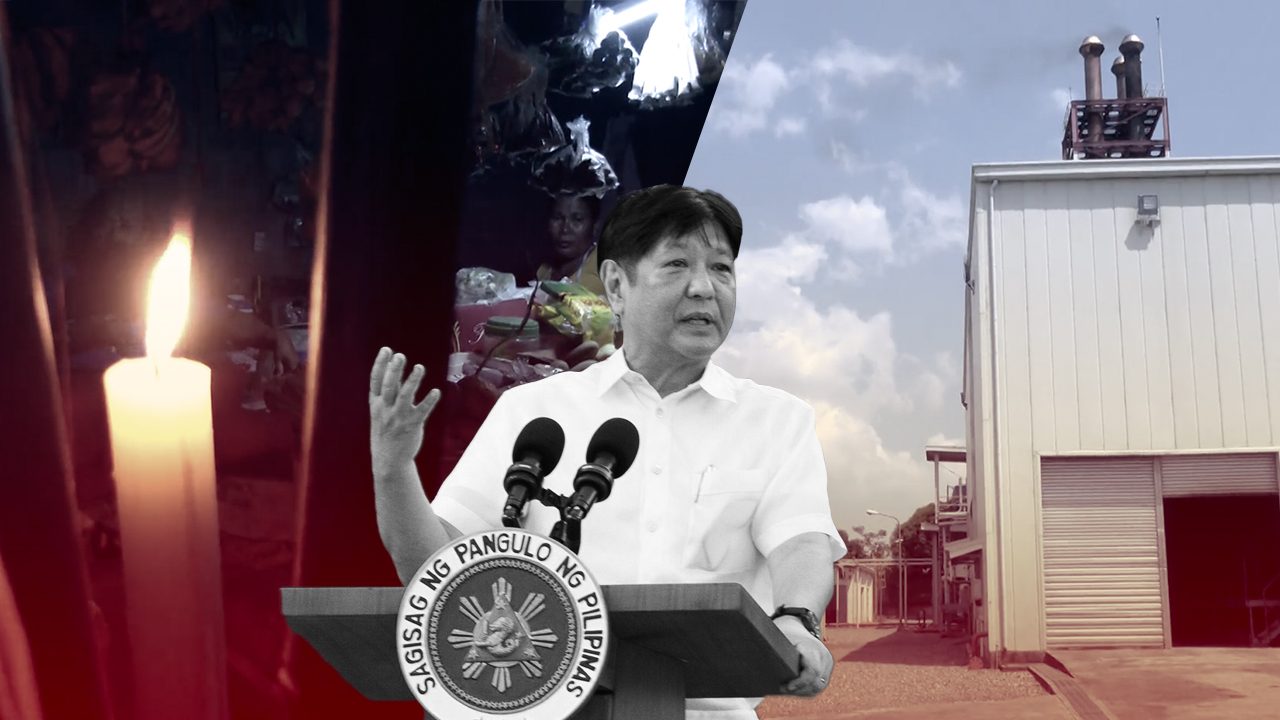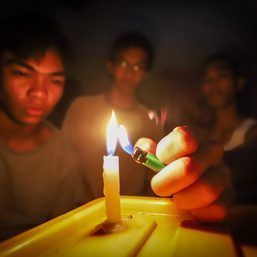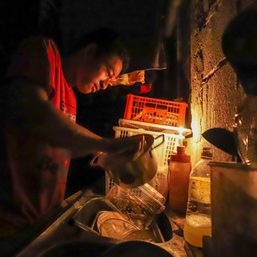SUMMARY
This is AI generated summarization, which may have errors. For context, always refer to the full article.

OCCIDENTAL MINDORO, Philippines – “Kuryente, kuryente, kuryente!“
That was the playful chant of Occidental Mindoro residents when Ferdinand Marcos Jr. visited the province as a presidential aspirant on April 20, 2022. He was in the middle of his speech when his supporters – who were enduring the summer heat – tried to catch his attention regarding the issue of power outages.
Reading the room correctly, Marcos quipped, “Inunahan ‘nyo naman ako eh (I was already about to get to that!)”
He then pulled out from his pocket a piece of paper and told his enthusiastic audience that he had received their list of concerns, with power supply woes as priority No. 1.
“We need to fix this. This is a big problem,” he said.

A month after his visit, Occidental Mindoro delivered for Marcos, who received nearly half of the total number of votes in the province in the 2022 elections.
But a year later, the now-president has yet to deliver on his promise to the same people who believed he could get things done.
Bleak situation
Not only did the power outages continue since last year, it even took a turn for the worse.
Since March, residents all over the province are dealing with brownouts that last up to 20 hours every day.
Private fish port manager Jonathan Barlocha knows for sure that life has become more inconvenient. A shortage in ice caused by the brownouts has forced them to import ice blocks from Metro Manila to prevent their catch from rotting.
“The ice plant here could not provide us ice blocks consistently,” he said. “Last year, the situation was better.”

Stella Ortega, who owns a cold storage facility for onions in the town of San Jose, is also worried about the future of her business. To continue operations, her company has to turn on its big generator set every day. The fuel alone costs them P120,000 daily.
“We also had to replace our capacitor numerous times,” she added, referring to a machine that broke down as a result of the fluctuating voltage during brownouts.
Decades-long crisis
The history of power outages in Occidental Mindoro is complicated, messy, and long, dating back to the 1990s.
But there was initially a glimmer of hope in 2014, when power distributor Occidental Mindoro Electric Cooperative (Omeco) entered into a power-sharing agreement with Emerging Power Incorporated (EPI).
EPI had been tasked to build two power plants that would be the source of the province’s energy supply. These were:
- a 44-megawatt geothermal power plant in Naujan, Oriental Mindoro (main source)
- a 20-megawatt bunker fuel power plant in San Jose, Occidental Mindoro (backup source)
The first project suffered indefinite delays until it was ultimately scrapped, while the second project became operational in 2017.
Because EPI was unable to fulfill its commitments, Omeco terminated its agreement with the company, and the province was left with the 20-megawatt power plant that was originally only intended to be a backup source of energy supply. Its current operator is the Occidental Mindoro Consolidated Power Corporation (OMCPC).
Basic math dictates that a 20-megawatt facility could not keep up with the daily power demand of the province at 27 megawatts as of 2021 (and 30 megawatts as of 2023, according to Omeco).
The Energy Regulatory Commission eventually instructed Omeco in 2019 to look for a new power supplier, but the competitive selection process dragged on for years that ERC briefly penalized Omeco in 2022.
Finger-pointing
Freshman lawmaker Odie Tarriela, who represents Occidental Mindoro in the 19th Congress, called for an inquiry into the power supply fiasco through a scathing House resolution that blamed Omeco for the mess.
“Omeco failed to provide electricity in the least cost manner to its franchise area for the past years,” his August 2022 resolution read.
Omeco, however, disputed allegations of mismanagement, insisting that red tape in government agencies and pandemic-driven setbacks were the cause of delay.
“When we released the invitation to bid, 23 to 24 suppliers expressed interest. But after the Department of Energy (DOE) changed the contract’s terms…a delay occurred due to pre-bid conferences where points of clarification had to be made. That’s a long process,” Omeco board of directors president Eleanor Costibolo told Rappler.

More finger-pointing
Power provider OMCPC has also earned the ire of residents for either shutting down its power plant (which at some point led to blackouts) or reducing its energy supply (causing constant rotational brownouts).
While the power plant is capable of supplying 20 megawatts per day, OMCPC argued that the ERC allows them to provide 12 megawatts only. The facility, however, has reduced that number further to seven, citing its incapability to buy fuel due to delayed subsidy payments of the National Power Corporation (NPC).
“Just imagine the almost P1.2 billion in uncollected subsidy payment from NPC. How can we operate our power plant with that amount? They said that ‘you have to produce more money from your own pocket just to sustain your operation,’ but this is business, I remind you,” OMCPC communications officer Boy Ilustre told Rappler.
For context, Occidental Mindoro is not connected to the national grid, which means supplying electricity in the province is more expensive. It also means that NPC is required by law to help the province offset power costs in the form of subsidies.
NPC, however, said it could not make the payments at the moment due to the agency’s funding deficit in the wake of the global surge in oil prices.
The provincial government, meanwhile, lambasted OMCPC for supposedly choosing profit over public service.
“OMCPC earns millions of pesos from their exclusive contract with Omeco and their province. They entered into this agreement with their eyes open, and NPC told them it will take time before OMCPC is able to collect subsidy payments. They should know that they took part in a capital-intensive business,” Vice Governor Diana Tayag told Rappler.
“It is unacceptable that every time they have a problem with their cash flow, they resort to shutting down the plant,” she added. “It’s like the people of Mindoro are being taken hostage, and we have no choice but to cave in to their wishes.”

But OMCPC made it clear that funds from NPC would allow the corporation to increase the energy supply that it provides.
“Once the delayed subsidy payments are fulfilled, we can assure you that the 12-megawatt approved contract will run,” Ilustre said.
Growing outrage
Farmer and grassroots organizer Denden Aguilar admitted he sometimes gets lost in the technicalities of the power supply mess that has traumatized his province.
But this, he knows for sure: electricity is a public utility, which people pay to have in their homes, so they should get what they deserve.
Fed up with the brownouts, Aguilar and other like-minded colleagues organized a string of protests to amplify their call for a solution.

He said a demonstration they mounted in mid-April brought together over a thousand participants from various sectors: teachers, students, entrepreneurs, priests, nuns, and their Muslim brothers and sisters.
“If we won’t publicly air our grievances, our lives will stay the same, we won’t be able to live normally,” the OKSI Walang Power Movement convener told Rappler.
Aguilar and many other residents have begun flooding Facebook with stories about the impact of the power crisis, and putting the hashtag “SOSPBBM,” which is basically a plea for help addressed to President Marcos.

Untangling the mess
A few band-aid solutions have been made to ease Mindoreños’ suffering:
- The provincial government declared a state of calamity, allowing them to tap into special funds that would ensure continuous operations of essential public services, like hospitals.
- NPC gave P100 million to OMCPC as partial payment, which would allow the latter to buy fuel for its operations.
- The DOE gave Omeco the clearance to undertake a negotiated procurement to find a new contractor that would supply 17 megawatts of fuel for a maximum of one year from April 31, 2023.
But Omeco, OMCPC, the provincial government, and the OKSI Walang Power Movement all told Rappler during our two-day field work in the province that Marcos himself already needs to intervene.
With all major parties in the power supply fiasco blaming one another for the brownouts that have plagued the province, they believe it already takes the country’s top leader to stop the bleeding.
“This is like a traffic jam among Omeco, OMCPC, NPC, and ERC. There must be a traffic enforcer that would untangle this mess. The DOE or Office of the President should address this,” Omeco’s Costibolo said.
“When he visited Mindoro during the campaign, he said Mindoro will be his priority. So we are now waiting for that fulfillment of the promise made by the president of the country,” OMCPC’s Ilustre added.
Earlier in April, Marcos went back to Mindoro island – although only in Oriental Mindoro to monitor the oil spill situation there – and was asked by reporters what he thinks of the power crisis in Occidental Mindoro.
He said the solution is submarine cables, and renewable energy.
“Solar could be used in any part of the Philippines. We are also studying the possibility of using wind energy so that Mindoro would no longer depend on other areas for their electricity,” he said.
But those ambitions take time, and residents said they need a more urgent fix.
“Since our problem is the unpaid subsidies, can’t President Marcos find a way?” grassroots organizer Aguilar asked.
“If we have to picket outside Malacañang, we will do it,” he asserted.
For now, a province of more than 500,000 inhabitants makes do with what they have: some are using batteries from motorcycles to charge their light, some have purchased small solar panels, and some have invested in generator sets.
But those who are less fortunate will just have to continue to endure this dark chapter of their lives. Literally.

– Rappler.com
Add a comment
How does this make you feel?



![[Just Saying] SONA 2024: Some disturbing points](https://www.rappler.com/tachyon/2024/07/TL-marcos-sona-points-july-23-2024.jpg?resize=257%2C257&crop=335px%2C0px%2C720px%2C720px)






![[ANALYSIS] Why do we pay higher power rates when we have power outages?](https://www.rappler.com/tachyon/2024/07/tl-higher-power-rates-higher-power-outages.jpg?resize=257%2C257&crop=401px%2C0px%2C1080px%2C1080px)




There are no comments yet. Add your comment to start the conversation.